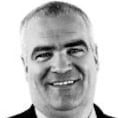Although difficult, it is interesting to try and project oneself into the mind of a historian who in 10, 20 or 30 years' time is asked to edit a book, CD Rom or online resource for students studying the history of Ireland in the first decade of the 21st century.
One wonders what images and stories from the last 12 months he or she would include.
Ian Paisley and Martin McGuinness will definitely have to get prominence in any such history.
The true significance of the political change that has occurred in Northern Ireland was clear to most people living there when a single picture of Gerry Adams and Ian Paisley sitting on the same corner of a table emerged from the carefully choreographed first meeting between Sinn Féin and the DUP at Stormont in late March.
The true impact of these events was brought home to those of us in the Republic two weeks later with pictures of Ian Paisley's enthusiastic handshake with Bertie Ahern at Farmleigh in early April and again when he presented the Taoiseach with a musket during his visit to the site of the Battle of the Boyne in May.
Since May, pictures of Ian Paisley as First Minister laughing and joking with Martin McGuinness as Deputy First Minister have served to illustrate the new political dispensation.
They are now pictured together so frequently and the body language between them has been so comfortable that Belfast wags have begun to call them the "chuckle brothers".
A Google image search already throws up several hundred Paisley-McGuinness double shots including the duo laughing on the staircase in Stormont, at the New York Stock Exchange on their recent US tour and even lounging on couches at the opening of the new Ikea store in Belfast.
Anyone searching for an image to represent the most significant political events of 2007 in the Republic would probably settle on one of Bertie Ahern and Enda Kenny squaring up to each other in the televised election debate, not only because it marked a turning point in the campaign but because it crystallised the nature of the election itself. Unlike previous elections it was, at least initially, a real contest between alternative taoisigh.
There are also many images from the 48 hours after the election which could be used to convey the dramatic outcome.
For the audio version, our history editor could do worse than select the sound clip of the start of Morning Ireland at 7am on May 25th, 2007, when the results of the RTÉ/Lansdowne Market Research exit poll were published and the true extent of the strength of the late swing to Fianna Fáil was revealed. From that moment it was clear that Bertie Ahern would again be Taoiseach for a historic third term.
The only question remaining was who he would be in government with.
There are many images from the first meeting of the Dáil on June 10th, 2007, which could be used to reflect the nature of the political change and continuity brought by the election and the subsequent negotiations. Camera shots panning opposition benches showed a Fine Gael with dozens of new deputies restored to its dominance on that side of the house.
Bertie Ahern rising in the Dáil to announce his new Government was also a dramatic and historic moment not least because of the novelty of two Green Party Ministers.
Our history editor from his or her perspective 20 or 30 years hence may also regard it as particularly significant that Brian Cowen was elevated to the position of Tánaiste in June 2007.
The social and economic history of Ireland will also have to feature and that story could best be told by harvesting the detail in the 2006 census, the finalised figures for which were published in April this year.
There is a wealth of information there to show how Ireland has been demographically transformed with massively increased employment opportunities for both men and women, a significant rise in the relative importance of the counties around Dublin and, most significantly of all, the arrival to Ireland of tens of thousands of immigrants, most of them from central and eastern Europe. If the history editor wanted to convey the difficulties which the Government has experienced since its re-election, then various intemperate Dáil exchanges on Shannon, on provisional driving licences and especially on ministerial pay rises will achieve that.
It remains to be seen, of course, how historians in the future will treat the various controversies about Bertie Ahern's personal finances and his appearances at the Mahon tribunal which have been such a feature of news coverage this year.
If the complex web of allegations and financial details is difficult for today's readers and viewers to follow, it will be almost impenetrable for history students of the future.
One thing is for sure, history will not give Ahern's finances and the tribunal deliberations anything like the prominence which present day journalism is giving it.
Again this week, the sheer volume of newsprint and air space devoted to this story has been disproportionate.
It is extraordinary, for example, that in the last 48 hours some individual newspapers and radio and TV programmes have given more prominence to the most recent instalment of the Taoiseach's evidence to the tribunal than to the verdict in the Omagh bombing case, which surely must be a more significant story.
One gets the sense that some of the media have covered the minutiae of the tribunal to such an extent because they have committed resources to Dublin Castle or in some instances because it suits a particular agenda and not actually because what is happening there is newsworthy on a given day.
Future historians will, of course, have the advantage of a final report from the Mahon tribunal and of knowing whether or not the tribunal revelations ultimately did actually precipitate the premature end to the Ahern era which so many are now confidently predicting.
